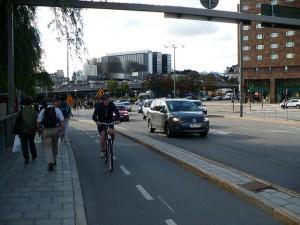 There has been much discussion lately about bicycle safety and etiquette. The New York Times recently ran a provocative op-ed that asked, “Is it okay to kill a cyclist?” The obvious answer is an unequivocal “no.” There are some shortcomings to the article beyond its suggesting that there could even be a different answer to that question. Yet the article does raise at least one good point: as more and more people choose to be cyclists, how can we ensure that our social and legal culture– and the road itself, the op-ed points out– catch up?
There has been much discussion lately about bicycle safety and etiquette. The New York Times recently ran a provocative op-ed that asked, “Is it okay to kill a cyclist?” The obvious answer is an unequivocal “no.” There are some shortcomings to the article beyond its suggesting that there could even be a different answer to that question. Yet the article does raise at least one good point: as more and more people choose to be cyclists, how can we ensure that our social and legal culture– and the road itself, the op-ed points out– catch up?
Daniel Duane, the author of the op-ed, argues for the utilitarian purpose of bicycling. He observes that, “… cycling isn’t sky diving. It’s not just thrill-seeking, or self-indulgence. It’s a sensible response to a changing transportation environment, with a clear social upside in terms of better public health, less traffic and lower emissions.” Indeed, cycling is a “sensible” activity one that promotes health, can ease congestion on roads and contribute to a reduction in greenhouse gas emissions. But there’s this fallacy that we can plop bikes into a city and expect it to work. Indeed, Duane is right to point out that it’s a perfectly normal thing to bike, but this normal activity needs social norms, a legal culture and streets designs that support it if it’s going to continue, be safe and actually achieve its aims.
New York Magazine also ran an article this week that noted bicyclists tend to not stop at red lights. Not only was the article not exactly an amazing feat of investigative journalism, but it also missed an important point that supports Duane’s conclusions: bikes are not cars. Lights are timed to keep car traffic moving at a certain level of speed. But bikes move at different speeds; no they don’t go as fast as cars, but on high-traffic streets there are definitely advantages to being on two instead of four wheels. The point is that bicyclists should obey the laws, but we have to think about who the laws are meant for and if they really serve and promote the safety of those who are to adhere to them as well as motor vehicles and pedestrians.
Our roads need bike lanes (preferably protected lanes). But just as important are norms that support and encourage biking and we also need laws built around the reality that is biking. Doing so recognizes the many positive externalities of biking and further creates a cycling environment safe for bicyclists and drivers alike.




